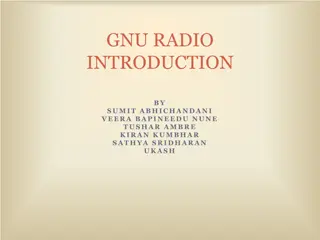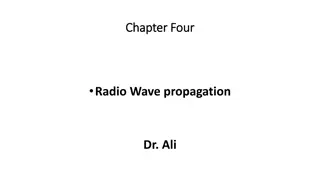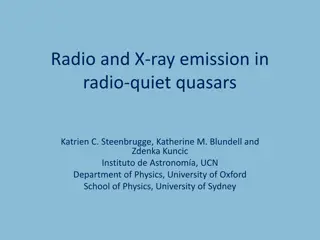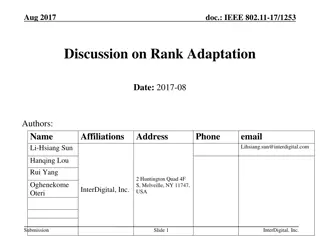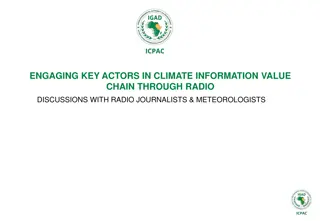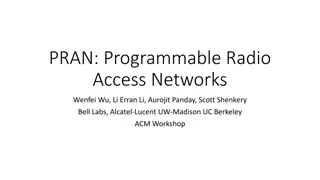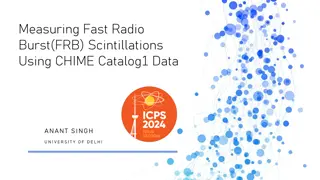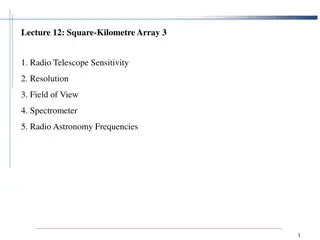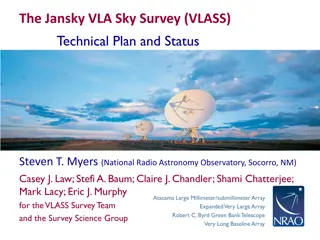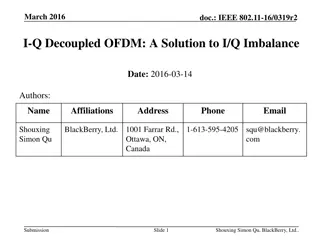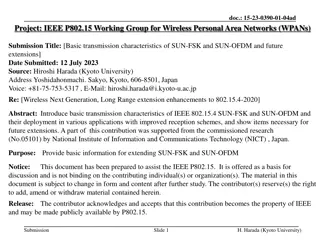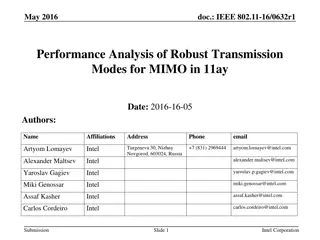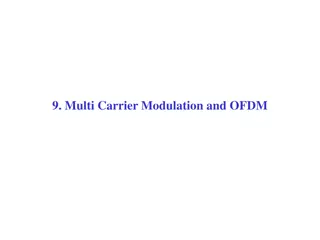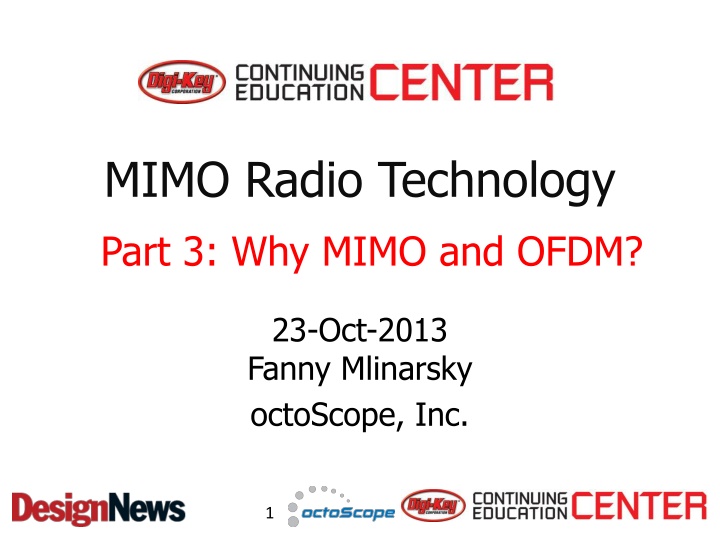
the Advantages of MIMO and OFDM in Wireless Technology
Explore the benefits of Multiple Input Multiple Output (MIMO) and Orthogonal Frequency Division Multiplexing (OFDM) in improving wireless performance, throughput, range, and capacity. Learn why OFDM is a robust signaling scheme for hostile wireless channels, used in various modern wireless standards. Discover the role of OFDM in transforming fading channels, and the importance of cyclic prefix in mitigating intersymbol interference.
Uploaded on | 0 Views
Download Presentation

Please find below an Image/Link to download the presentation.
The content on the website is provided AS IS for your information and personal use only. It may not be sold, licensed, or shared on other websites without obtaining consent from the author. If you encounter any issues during the download, it is possible that the publisher has removed the file from their server.
You are allowed to download the files provided on this website for personal or commercial use, subject to the condition that they are used lawfully. All files are the property of their respective owners.
The content on the website is provided AS IS for your information and personal use only. It may not be sold, licensed, or shared on other websites without obtaining consent from the author.
E N D
Presentation Transcript
MIMO Radio Technology Part 3: Why MIMO and OFDM? 23-Oct-2013 Fanny Mlinarsky octoScope, Inc. 1
Outline This lecture will examine Wireless performance issues, such as throughput, range and capacity Advantages of MIMO and OFDM over legacy wireless technologies 2
Path Loss and Multipath In a wireless channel the signal propagating from TX to RX experiences fading and multipath Free space loss (flat fading) increases vs. frequency Fading can be flat or it can have multipath components Multipath can be caused by mobile or stationary reflectors. Loss (dB) = 20 * Log10 (frequency in MHz) + 20 * Log10 (distance in miles) + 36.6 Path loss in free space 2.4 GHz 915 MHz 81 dB 74 dB Multipath fading component +10 dB 0 dB Distance 5.8 GHz 160 feet 65 dB -15 dB flat fading component Time 3
Why OFDM? OFDM transforms a frequency- and time-variable fading channel into parallel correlated flat-fading channels, enabling wide bandwidth operation Channel Quality Frequency Frequency-variable channel appears flat over the narrow band of an OFDM subcarrier. OFDM = orthogonal frequency division multiplexing MIMO = multiple input multiple output 4
OFDM (Orthogonal Frequency Division Multiplexing) Multiple orthogonal carriers Voltage Frequency OFDM is the most robust signaling scheme for a hostile wireless channel Works well in the presence of multipath thanks to multi-tone signaling and cyclic prefix (aka guard interval) OFDM is used in all new wireless standards, including 802.11a, g and draft 802.11ac, ad 802.16d,e; 802.22 DVB-T, DVB-H, DAB LTE is the first 3GPP standard to adopt OFDM DVB = digital video broadcasting DVB-T = DVB terrestrial DVB-H = DVB handheld DAB = digital audio broadcasting LTE = long term evolution OFDM = orthogonal frequency division multiplexing 5
Cyclic Prefix Guard interval > delay spread in the channel Useful data TS copy Cyclic Prefix (CP) is a guard interval that allows multipath reflections from the previous symbol to settle prior to receiving the current symbol. CP has to be greater than the delay spread in the channel. CP eliminates Intersymbol Interference (ISI) and makes the symbol easier to recover. 6
OFDM vs. OFDMA OFDM is a modulation scheme Time Time OFDMA is a modulation and access scheme Frequency Frequency per user is dynamically allocated vs. time slots Frequency allocation per user is continuous vs. time User 1 User 2 User 3 User 4 User 5 OFDM/OFDMA = orthogonal frequency domain multiplexing / multiple access 7
LTE Resource Allocation 180 kHz, 12 subcarriers with normal CP User 2 User 3 User 2 User 1 0.5 ms 7 symbols with normal CP User 2 User 3 User 2 User 1 User 2 User 3 User 3 User 2 Time User 2 User 1 User 1 User 3 User 2 User 1 User 3 User 1 Resource Block (RB) Frequency Resources are allocated per user in time and frequency. RB is the basic unit of allocation. RB is 180 kHz by 0.5 ms; typically 12 subcarriers by 7 OFDM symbols, but the number of subcarriers and symbols can vary based on CP CP = cyclic prefix 8
Resource Block A resource block (RB) is a basic unit of access allocation. RB bandwidth per slot (0.5 ms) is 12 subcarriers times 15 kHz/subcarrier equal to 180 kHz. 1 slot, 0.5 ms Resource block 12 subcarriers Subcarrier (frequency) 1 subcarrier Resource Element 1 subcarrier QPSK: 2 bits 16 QAM: 4 bits 64 QAM: 6 bits v Time 9
LTE Scalable Channel Bandwidth Channel bandwidth in MHz Transmission bandwidth in RBs Center subcarrier (DC) not transmitted in DL Channel bw 1.4 3 5 10 15 20 MHz Transmission bw # RBs per slot 1.08 2.7 4.5 9 13.5 18 6 15 25 50 75 100 10
MIMO Systems MIMO systems are typically described as NxM, where N is the number of transmitters and M is the number of receivers. TX TX 2x2 RX RX MIMO radio channel TX TX RX RX MIMO = multiple input multiple output 2x2 radio 2x2 radio 11
Multiple Antenna Techniques SISO (Single Input Single Output) Traditional radio MISO (Multiple Input Single Output) Transmit diversity (STBC, SFBC, CDD) SIMO (Single Input Multiple Output) Receive diversity, MRC MIMO (Multiple Input Multiple Output) SM to transmit multiple streams simultaneously; can be used in conjunction with CDD; works best in high SNR environments and channels de-correlated by multipath TX and RX diversity, used independently or together; used to enhance throughput in the presence of adverse channel conditions Beamforming SM = spatial multiplexing SFBC = space frequency block coding STBC = space time block coding CDD = cyclic delay diversity MRC = maximal ratio combining SM = Spatial Multiplexing SNR = signal to noise ratio 12
MIMO Based RX and TX Diversity When 2 receivers are available in a MIMO radio MRC can be used instead of simple diversity to combine signals from two or more antennas, improving SNR MIMO also enables transmit diversity techniques, including CDD, STBC, SFBC TX diversity is used to spread the signal so as to create artificial multipath to decorrelate signals from different transmitters so as to optimize signal reception Peak Null MIMO = multiple input multiple output SIMO = single input multiple outputs SM = spatial multiplexing SFBC = space frequency block coding STBC = space time block coding CDD = cyclic delay diversity MRC = maximal ratio combining SM = Spatial Multiplexing SNR = signal to noise ratio Delay is inside the TX 13
Beamforming and Beam Steering Beamforming is a feature of 802.11ac and central to 802.11ad Optimizes the range by focusing the energy between transmitting and receiving nodes 14
Data Rate Adaptation MIMO radios adapt their operating mode to the changing channel conditions, optimizing throughput and minimizing PER Example of rate adaptation is MCS adaptation employed by 802.11n/ac and LTE radios. PER = packet error rate MCS = modulation coding scheme 15
IEEE 802.11a,b,g,n Data Rates 20 MHz Channel 40 MHz Channel 1 stream 2 streams 3 streams 4 streams 1 stream 2 streams 3 streams 4 streams Data Rate, in Mbps 1, 2, 5.5, 11 802.11b 2.4 GHz 6, 9, 12, 18, 24, 36, 48, 54 802.11a 5 GHz 1, 2, 6, 9, 12, 18, 24, 36, 48, 54 802.11g 2.4 GHz 6.5, 13, 19.5, 26, 39, 52, 58.5, 65 13, 26, 39, 52, 78, 104, 117, 130 19.5, 39, 58.5, 78, 117, 156, 175.5, 195 26, 52, 78, 104, 156, 208, 234, 260 13.5, 27, 40.5, 54, 81, 108, 121.5, 135 27, 54, 81, 108, 162, 216, 243, 270 40.5, 81, 121.5, 162, 243, 324, 364.5, 405 54, 108, 162, 216, 324, 432, 486, 540 802.11n 2.4 and 5 GHz 28.9, 57.8, 86.7, 115.6, 173.3, 231.1, 260, 288.9 14.4, 28.9, 43.3, 57.8, 86.7, 115.6, 130, 144.4 7.2, 14.4, 21.7, 28.9, 43.3, 57.8, 65, 72.2 21.7, 43.3, 65, 86.7, 130, 173.3, 195, 216.7 15, 30, 45, 60, 90, 120, 135, 150 30, 60, 90, 120, 180, 240, 270, 300 45, 90, 135, 180, 270, 360, 405, 450 60, 120, 180, 240, 360, 480, 540, 600 802.11n, SGI enabled 2.4 and 5 GHz SGI = short guard interval 16
Rate Adaptation Example 11ac Max 802.11ac data rate with 3 spatial streams Source: IEEE P802.11ac/D7.0, September 2013; Table 22-48 GI = guard interval 17
TGac Next Generation Wi-Fi Up to 6.9 Gbps of PHY data rate (draft 0.1) Higher order MIMO (> 4x4) 8 spatial streams Multi-user (MU) MIMO Up to 4 users; up to 4 streams per user Higher bandwidth channels (20, 40, 80, 80+80 and 160 MHz) MU-MIMO Multiple beamformed streams in the same channel 18
802.11ad 60 GHz Channels Channel f c (GHz) Country 1 58.32 US Channel 2 must be supported 2 60.48 US, Japan, EU, Australia 3 62.64 US, Japan, EU 4 64.80 Japan, EU IEEE 802.11ad is the key standard; other specifications are: 802.15.3c, ECMA-387, WirelessHD EIRP: (40 dBm avg, 43 dBm peak in the US; 57 dBm in Europe, Japan and Australia Channel spacing = 2160MHz 19
MIMO vs. SISO Throughput MIMO = multiple input multiple output SISO = single input single output 20
Wireless Performance Factors Factors MIMO channel correlation Explanation/Impact Function of several variables including device antenna spacing, antenna polarization and multipath Related to correlation and strongly influenced by multipath in the channel Notes The lower the correlation the higher the throughput Angular spread of the received signal Multipath causes signal to bounce around and arrive at different angles, thereby widening the angular spread at a receiver. Typically, the wider the angular spread the higher the MIMO throughput. MIMO throughput will vary vs. device orientation and antenna spacing. Typically, the wider the antenna spacing the lower the correlation and the higher the throughput. Cross-polarization (e.g. both vertical and horizontal) is sometimes used to lower MIMO correlation, thus enabling spatial multiplexing. Multipath reflections can alter polarization. Device antenna spacing and device orientation Related to angular spread and correlation Antenna polarization Vertical, horizontal or circular 21
Wireless Performance Factors Factors Explanation/Impact Notes Noise and interference High noise power with respect to signal power results in low SNR (signal to noise ratio) conditions. The term SINR (signal to interference + noise ratio) is sometimes used Causes Doppler spread of the signal MIMO devices can adapt to the environment by selecting the most suitable mode of operation (e.g. TX diversity in low SNR conditions; spatial multiplexing in high SNR, low correlation conditions) Motion of devices or multipath reflectors OFDM signaling is particularly sensitive to Doppler spread. Throughput should be measured in a variety of Doppler environments. 22
Escalating Complexity Scheduling Rate adaptation HARQ Data transmissions Complex MIMO radio technology Spatial multiplexing, TX/RX diversity, beamforming, MU-MIMO Multiple radio networks (2G/3G/LTE, Wi-Fi) Complex protocols Mobility management (handover) Cell-edge interference avoidance Self-organizing behavior Industry needs new generation sophisticated test methodologies to ensure devices and systems work in the field Serving cell Non-serving cell MU = multi-user MIMO = multiple input multiple output HARQ = Hybrid Automatic Repeat ReQuest 23
Summary Both the channel environment and the radio operating mode are time variable and interdependent, making it challenging to obtain repeatable test results. OFDM and MIMO make it possible for radios to adapt to a variety of channel conditions. Testing this adaptation behavior requires controlled emulation of different channel conditions, which is the subject of tomorrow s lecture. 24
Next Session Part IV: Measuring Wireless Performance Thursday, October 24th, 2013 2 pm EST Visit www.octoscope.com for more material and test solution information 25

